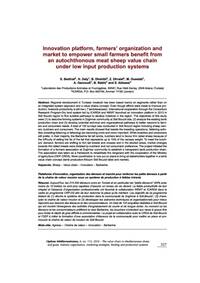Innovation Platform, Farmers’ Organizations, and Market to Empower Small Farmers Benefit from an Autochthonous Meat Sheep Value Chain Under Low Input Production Systems

Authors:
Regional development in Tunisian livestock has been based mainly on segments rather than on an integrated system approach and a value chains concept. Even though efforts were made to improve production, livestock productivity is still low (.7 lamb/ewe/year). International cooperation through the Consortium Research Program-Dry land system led by ICARDA and INRAT launched an innovation platform in 2013 in Sidi Bouzid region to find suitable pathways to develop livestock in the region. The objectives of this study were 1) to describe farming systems in Zoghmar community at Sidi Bouzid site; 2) analyze the existing lamb production chain and 3) develop potential technical and organizational pathways to better respond to farmers and consumers needs. A total of 120 surveys was conducted in Sidi Bouzid region including sheep owners, butchers and consumers. The main results showed that beside the breeding operations, fattening activities (breeding-fattening or fattening) are becoming more and more important. While breeders and consumers still prefer, in their majority, the Barbarine fat tail lambs, butchers tend to favour thin tailed sheep because of the difficulty of selling the fat of the tail that represents up to 15% of the carcass weight. To meet the butchers’ demand, farmers are shifting to thin tail breeds and crosses and in the studied areas, market changes towards thin tailed breeds were dictated by butchers’ and not consumers’ preference. The project initiated the formation of a farmers association at Zoghmar community to establish a transparent lamb production chain. The association was taken as a framework to rehabilitate the rangeland with the cooperation of the Ministry of agriculture (OEP-CRDA). More coordination is now put on place to bring all stakeholders together in a lamb value chain concept (lamb production-Allouch Sidi Bouzid label and market).
